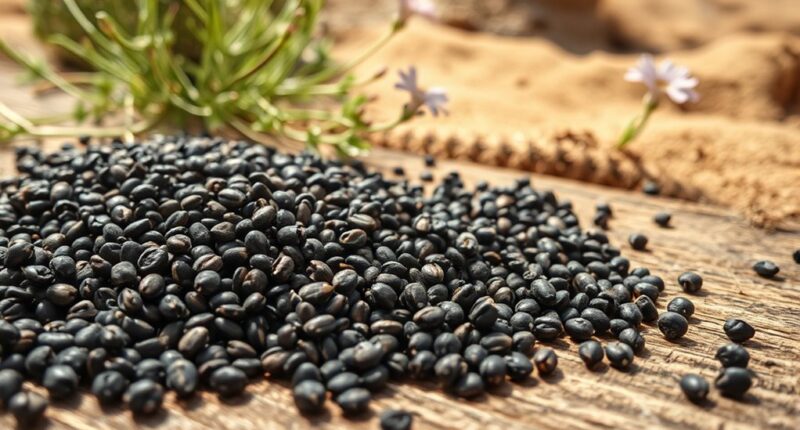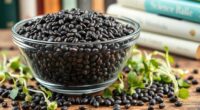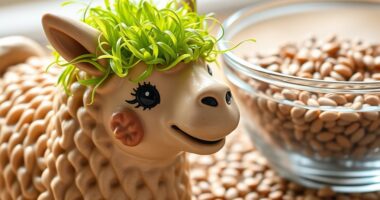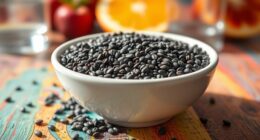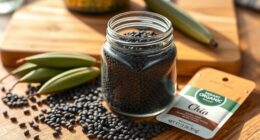Chia comes from *Salvia hispanica*, a hardy mint family plant native to arid Central and South America. Its adaptations, like drought-resistant leaves and deep roots, help it survive tough environments. When it flowers, pollinators like bees help produce tiny, tough-coated seeds that can stay dormant until conditions are right. Thanks to these resilient traits, chia seeds have moved from desert regions to your pantry, and there’s much more to discover about this fascinating plant’s journey.
Key Takeaways
- Chia is derived from *Salvia hispanica*, a drought-resistant plant native to Central and South America.
- Its botanical adaptations, like small leaves and deep roots, enable survival in arid environments.
- Chia produces vibrant flowers that attract pollinators, leading to seed dispersal by gravity, wind, and animals.
- The seeds have a tough coat, ensuring viability and resilience through dormancy and harsh conditions.
- Human cultivation and seed robustness have facilitated its transition from desert native to a globally cultivated staple.
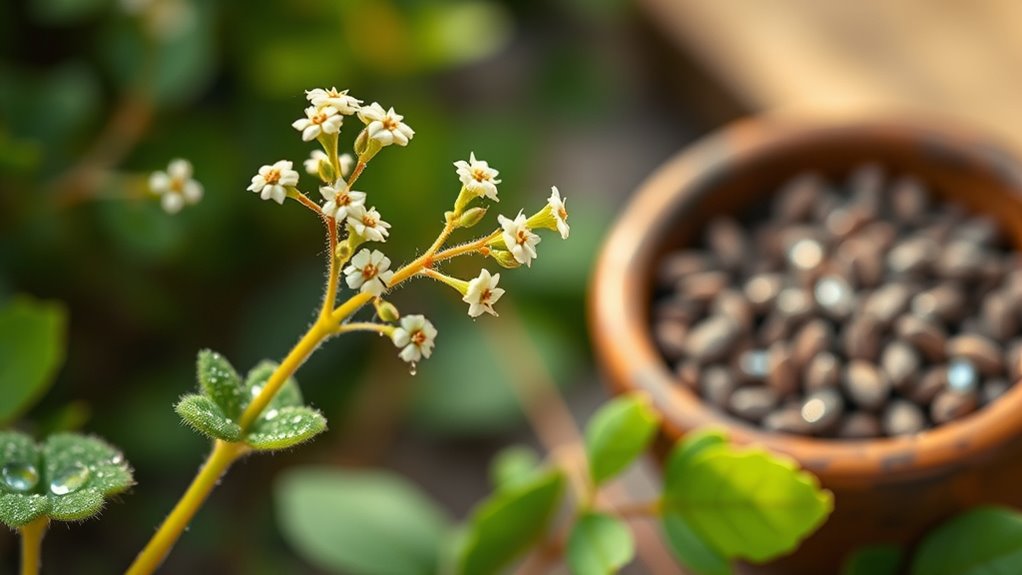
Chia seeds come from a flowering plant known as Salvia hispanica, a member of the mint family native to Central and South America. As you explore this plant’s botany, you’ll notice how its unique adaptations help it thrive in challenging environments. Salvia hispanica has evolved specific plant adaptations that enable it to survive arid conditions and compete for resources. Its small, drought-resistant leaves minimize water loss, and the plant’s deep root system taps into underground moisture, giving it an advantage in dry soils. These features allow it to flourish where other plants might struggle, making it well-suited for the semi-arid regions of its native range.
Understanding seed dispersal is key to appreciating how chia plants propagate and maintain their populations. When the plant blooms, it produces vibrant purple or white flowers that attract pollinators like bees and hummingbirds, ensuring effective pollination. After fertilization, the plant forms small, oval-shaped seeds—these are the chia seeds you find in health food stores. Once mature, the seeds are dispersed primarily through natural mechanisms such as gravity and animal activity. As the seeds ripen, they often fall to the ground, where they can be carried away by wind or animals. Some animals might eat the seeds and later disperse them through their droppings, aiding in the spread of chia plants across different areas. This seed dispersal strategy increases the chances of the plant colonizing new, suitable habitats, especially in regions where it can face competition or environmental stress.
The plant’s adaptations extend to its reproductive strategy, too. Its small seeds are equipped with a tough seed coat that protects them during dispersal and dormancy, allowing them to remain viable in the soil until conditions are right for germination. This resilience ensures the plant can persist over time, even during periods of drought or limited rainfall. Additionally, the plant’s cultural heritage has contributed to its cultivation and spread worldwide, transforming it from a native desert plant to a global nutritional staple. As you observe the plant’s growth cycle, you’ll see how its seed dispersal mechanisms are finely tuned to maximize survival and spread. These traits not only help the chia plant endure in harsh environments but also make it a reliable source of nutrition and cultivation for humans. By understanding these botanical features, you gain insight into how a plant that originated in the desert can become a thriving crop and pantry staple worldwide.
Frequently Asked Questions
How Long Does Chia Seed Planting Take to Produce Harvestable Seeds?
When you plant chia seeds, the growth timeline to harvest maturity usually takes about 7 to 14 days for seedlings to develop. Full maturity for harvest typically occurs in 8 to 12 weeks, depending on growing conditions. You’ll want to monitor the plants closely, ensuring they receive enough sunlight and water. Once the flowers fade and seeds turn brown, it’s time to harvest your chia for a successful yield.
Can Chia Plants Grow Indoors or in Non-Desert Environments?
Yes, you can grow chia plants indoors or in non-desert environments. They adapt well to indoor cultivation with plenty of sunlight and well-draining soil. You’ll need to make sure the plant gets enough light and keep the soil moist but not waterlogged. With proper care, chia plants thrive outside their native desert habitat, making them a versatile addition to your garden or indoor space.
What Pests Commonly Affect Chia Plants During Cultivation?
Did you know that aphids are among the most common pests affecting chia plants? During cultivation, you’ll often encounter insects like aphids, spider mites, and whiteflies. Effective pest management is key to preventing damage, and developing insect resistance in plants can help reduce pesticide use. Keep a close eye on your chia crops, regularly inspect for pests, and act swiftly to protect your plants’ health and yield.
Are There Different Varieties of Chia With Distinct Botanical Features?
You’ll find that different chia varieties have unique botanical distinctions, which influence their appearance and growth habits. When comparing varieties, you can notice differences in seed size, color, and plant structure. Some popular ones include Salvia hispanica and Salvia pichinchensis, each with distinct features. Exploring these varieties allows you to appreciate the diversity within chia, helping you choose the best type for your cultivation or culinary needs.
How Does Climate Change Impact Chia Plant Growth and Yield?
Climate change threatens chia plant growth and yield by increasing drought frequency and unpredictable weather. You need to focus on enhancing climate resilience and drought adaptation strategies, like selecting drought-tolerant varieties and improving water management. These steps help guarantee chia plants thrive despite shifting conditions, securing your harvest. By adapting to climate challenges, you support sustainable cultivation and maintain the crop’s contribution to your diet and economy.
Conclusion
So, next time you sprinkle chia seeds on your yogurt, remember you’re wielding tiny desert marvels that defied harsh odds to reach your bowl. It’s almost poetic—these humble plants traded their arid origins for stardom in your pantry, all while quietly reminding us that even the most unassuming flora can conquer the world, one seed at a time. Truly, the botanical underdog story you never knew you needed, served with a side of crunchy irony.
